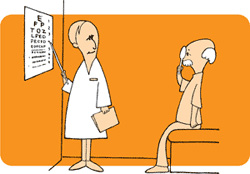Focus on Preventing Falls
 We all want to protect our older family members and help them stay safe, secure, and independent. Knowing how to reduce the risk of falling, a leading cause of injury, is a step toward this goal.
We all want to protect our older family members and help them stay safe, secure, and independent. Knowing how to reduce the risk of falling, a leading cause of injury, is a step toward this goal.
The Reality
Each year, one in every three adults ages 65 or older falls and 2 million are treated in emergency departments for fall-related injuries. And the risk of falling increases with each decade of life. The long-term consequences of fall injuries, such as hip fractures and traumatic brain injuries (TBI), can impact the health and independence of older adults. Thankfully, falls are not an inevitable part of aging. In fact, many falls can be prevented. Everyone can take actions to protect the older adults they care about.
Prevention Tips
You can play a role in preventing falls. Encourage the older adults you care about to:
- Get some exercise. Lack of exercise can lead to weak legs and this increases the chances of falling. Exercise programs like Tai Chi can increase strength and improve balance, making falls much less likely.
- Be mindful of medications. Some medicines—or combinations of medicines—can have side effects like dizziness or drowsiness. This can make falling more likely. Having a doctor or pharmacist review all medications can help reduce the chance of risky side effects and drug interactions.
 Keep their vision sharp. Poor vision can make it harder to get around safely. To help make sure they're seeing clearly, older adults should have their eyes checked every year and wear glasses or contact lenses with the right prescription strength.
Keep their vision sharp. Poor vision can make it harder to get around safely. To help make sure they're seeing clearly, older adults should have their eyes checked every year and wear glasses or contact lenses with the right prescription strength.
- Eliminate hazards at home. About half of all falls happen at home. A home safety check can help identify potential fall hazards that need to be removed or changed, like tripping hazards, clutter, and poor lighting.
Steps for Home Safety
The following checklist can help older adults reduce their risk of falling at home:
- Remove things you can trip over (like papers, books, clothes, and shoes) from stairs and places where you walk.
- Install handrails and lights on all staircases.
- Remove small throw rugs or use double-sided tape to keep the rugs from slipping.
- Keep items you use often in cabinets you can reach easily without using a step stool.
- Put grab bars inside and next to the tub or shower and next to your toilet.
- Use non-slip mats in the bathtub and on shower floors.
- Improve the lighting in your home. As you get older, you need brighter lights to see well. Hang light-weight curtains or shades to reduce glare.
- Wear shoes both inside and outside the house. Avoid going barefoot or wearing slippers.
More Information
CDC offers various materials and resources for all audiences about older adult falls and what can be done to prevent them. These resources are for the general public, public health officials, and anyone interested in programs that aim to prevent falls.
Get email updates
To receive email updates about this page, enter your email address:
Contact Us:
- Centers for Disease Control and Prevention
1600 Clifton Rd
Atlanta, GA 30333 - 800-CDC-INFO
(800-232-4636)
TTY: (888) 232-6348 - cdcinfo@cdc.gov




